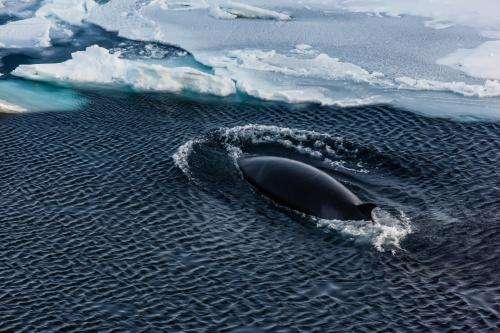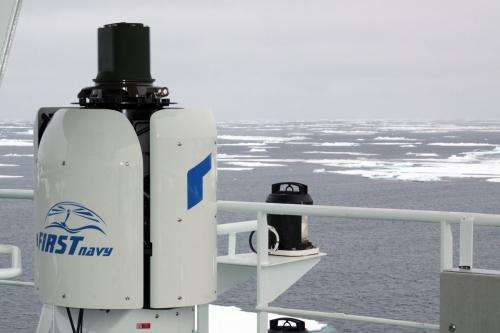New AWI thermal imaging system helps researchers to protect large whales from noise around the clock

Physicists at the Alfred Wegener Institute, the Helmholtz Centre for Polar and Marine Research, successfully tested a thermal imaging system aboard the research vessel Polarstern. The system automatically detects large whales by their spouts, day or night from distances up to five kilometres. As the scientists report in a recent study published in the journal PLOS ONE, the system detected significantly more whales than researchers using binoculars to spot the animals.
Pile driving during construction of wind farms and the use of airguns when searching for oil and gas unavoidably result in noise pollution in the surrounding area. To ensure that marine mammals are not harmed when in the close vicinity of these activities, regulatory authorities request so-called mitigation measures for their protection. One of such measures requires airguns to be switched off or pile driving to be stopped when whales approach the respective sound source too closely. Yet how to monitor the surrounding seas for whales around the clock - and that for weeks and weeks?
Humans obviously face clear limits: "Whoever has looked at the sea for any length of time, knows how quickly the eyes get tired and concentration dwindles. In addition: we cannot look in all directions at the same time and at night we virtually see nothing. Therefore it has been difficult, especially at night, to spot whales near vessels or marine platforms," says Dr. Daniel Zitterbart, a physicist at the Alfred Wegener Institute (AWI).
For this reason, he and colleagues from the AWI's "Ocean Acoustics Lab" advanced the infrared camera, "FIRST-Navy" from Rheinmetall Defence Electronics into a tool for automatic whale sightings over the past four years. During seven Polarstern expeditions they developed and successfully tested this high-tech system: "The thermal imaging camera is located at 28 metres height in Polarstern's windy crow's nest. It is mounted on an active gimbal that compensates the movements of the ship. The imager revolves five times per second and produces a 360-degree video stream of the vessel's environs, in which warmer regions appear brighter than colder ones. The thermal sensor is so sensitive that it detects differences in temperature of less than a hundredth of a degree Celsius. The whale spout, which, at least in subpolar and polar regions, is significantly warmer than the sea surface, appears as light grey or white fountains on these images," Daniel Zitterbart explains.

The video stream is processed by a software suite that he developed during his PhD. "A whale spout is bright on the thermal image and then becomes darker again in a very specific pattern. Our software divides each of the recorded images into 31,600 little snippets, which are individually examined for differences in brightness. Subsequently, the computer decides whether snippets exhibiting significant contrast change bear the characteristic features of a whale spout. This way we can also spot those animals that have emerged for only a very short breath of air," the physicist says.
The accuracy of the infrared detection system is impressive: As the researchers report in the journal PLOS ONE, direct comparisons during one of the expeditions showed that the camera recorded about twice as many whales near the vessel than scientists with binoculars trying to spot the animals. "The key strength of our system lies in the fact that we can locate large whales such as blue, fin, right and grey whales around the clock, especially at night, with great accuracy, allowing for a better protection. "Whenever an animal is detected by the system, appropriate safety measures are implemented," says Dr. Olaf Boebel, head of the AWI's ocean acoustics lab and co-author of the study.
At dark, as the comparative measurements showed, the data quality of the thermal imaging camera is even higher than during the day, because of the lack of light reflection on the water surface. And even in freezing weather, rough seas and at wind force 6, the AWI researchers were able to rely on their system. "The operating conditions go far beyond those weather conditions during which seismic surveys are usually carried out," says Olaf Boebel. For example: The deployment and recovery of the airguns becomes difficult when the waves are six meters or higher.
The whale detector is only prone to error when large numbers of birds fly simultaneously through the camera's field of view or countless smaller chunks of ice are floating on the ocean surface. "Until now we have designed our analysis software mainly for trips in open water because this is where airguns are mainly used for seismic surveys," says Daniel Zitterbart.
Following the successful test of the technology and software, he is already working on a system extension: "We now have a second, normal camera coupled to the infrared camera system. It automatically shoots photos of each whale detected by the IR system. This way, we can determine its species to collect data on the size and distribution of their respective populations," says Daniel Zitterbart. Another plus: the thermal imaging whale detectors also provide location and distance data for each whale, allowing AWI scientists to track the animals and explore their behaviour when they encounter vessels.
Next year the tested whale-tracking system is going to be installed permanently in Polarstern's crow's nest to be increasingly used on polar expeditions. The development team also plans to test the system in seas with a water temperature higher than 10 degrees Celsius. So far, it has passed its tests in polar and subpolar regions with flying colours.
More information: Daniel P. Zitterbart, Lars Kindermann, Elke Burkhardt, Olaf Boebel (2013): Automatic Round-the-Clock Detection of Whales for Mitigation from Undersea Noise Impacts, PLOS ONE, dx.plos.org/10.1371/journal.pone.0071217
Journal information: PLoS ONE
Provided by Helmholtz Association of German Research Centres



















